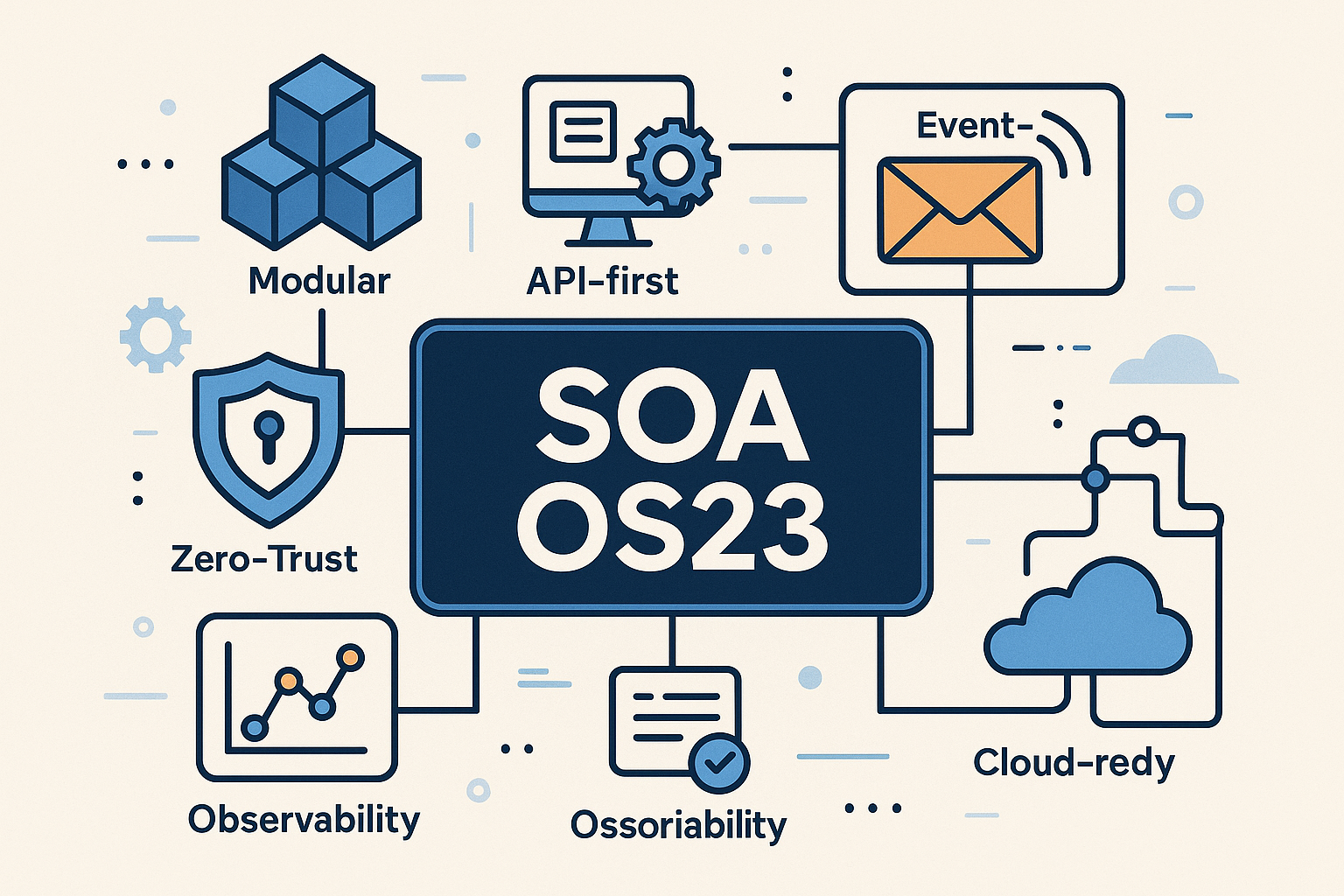
Sinkom: Revolutionizing Systems Through Synchronization, Communication, and Modularity
October 16, 2025
HMS Photovoltaik: Revolutionizing Solar Energy with Smart Management Systems
October 18, 2025In today’s fast-paced digital landscape, businesses are constantly seeking ways to enhance their software systems for better efficiency, scalability, and adaptability. Enter soa os23, a groundbreaking framework that’s transforming how organizations design and deploy applications. As technology evolves, soa os23 stands out as a pivotal advancement in service-oriented architecture, enabling seamless integration and modular development. This article delves deep into what soa os23 entails, its workings, benefits, and real-world applications, providing a comprehensive guide for tech enthusiasts, developers, and business leaders alike.
What Is SOA OS23?
At its core, soa os23 represents “Service-Oriented Architecture Open Standard 23,” a modern evolution of traditional service-oriented architecture (SOA) principles. Introduced as a response to the limitations of monolithic systems, soa os23 emphasizes the creation of independent, reusable services that communicate through standardized protocols. Unlike older architectures that often lead to rigid, hard-to-maintain codebases, soa os23 promotes modularity, allowing developers to build applications as a collection of loosely coupled services.
This standard emerged in 2023, hence the “23” designation, and has since gained traction for its focus on interoperability across diverse platforms. Whether you’re dealing with cloud-based solutions, on-premise systems, or hybrid environments, soa os23 ensures that services can interact without friction. It’s not just a technical specification; it’s a philosophy that prioritizes agility in software development, making it easier for teams to innovate and respond to market changes swiftly.
In essence, soa os23 bridges the gap between legacy systems and cutting-edge technologies like microservices and APIs. By adopting this approach, organizations can avoid the pitfalls of vendor lock-in and foster an ecosystem where services from different providers work harmoniously. This has made soa os23 a go-to choice for enterprises aiming to future-proof their IT infrastructure.
How Does SOA OS23 Work?
Understanding the mechanics of soa os23 is crucial to appreciating its value. The framework operates on a microservices-based model, where each service handles a specific function independently. Communication between these services occurs via APIs, ensuring efficient data exchange without heavy dependencies.
Key to its operation is the use of orchestration platforms that manage workflows. These platforms coordinate how services interact, handling tasks like routing requests, load balancing, and error recovery. For instance, if one service fails, the system can reroute to alternatives without disrupting the entire application.
Real-time monitoring is another cornerstone. Soa os23 incorporates tools for tracking performance metrics, allowing developers to identify bottlenecks proactively. Security is baked in from the ground up, with features like authentication and encryption ensuring data integrity across distributed services.
To illustrate, consider a e-commerce platform built on soa os23. The inventory management service might communicate with the payment gateway via APIs, while a separate analytics service processes user data in real-time. This decoupled structure means updates to one service don’t require overhauling the others, streamlining development cycles.
Key Features of SOA OS23
Soa os23 boasts a suite of features that set it apart from traditional SOA models. First and foremost is its emphasis on modularity. Services are designed to be self-contained, promoting reusability across multiple applications.
Interoperability is achieved through standardized protocols, such as RESTful APIs or SOAP, allowing seamless integration with third-party systems. The framework also supports efficient data flow, minimizing latency in service interactions.
Other notable features include:
- Scalability: Easily scale individual services to handle varying loads without affecting the whole system.
- Real-Time Insights: Built-in analytics for monitoring and optimizing performance.
- Security Protocols: Zero-trust models and encryption to protect sensitive data.
- Orchestration Tools: Automated management of service lifecycles and dependencies.
These elements make soa os23 particularly suited for dynamic environments like cloud computing and IoT ecosystems.
Benefits and Advantages of Adopting SOA OS23
The adoption of soa os23 brings numerous advantages that can significantly impact business operations. One of the primary benefits is enhanced flexibility. Organizations can adapt services to evolving needs without extensive rewrites, saving time and resources.
Scalability is another major plus. As demand grows, businesses can expand specific services independently, avoiding the costs associated with scaling monolithic applications. This is especially valuable in industries like finance and healthcare, where traffic can spike unpredictably.
Cost-efficiency stems from service reusability. By leveraging existing components, companies reduce development redundancy and maintenance overheads. Collaboration improves too, as standardized interfaces allow cross-functional teams to work more effectively.
Moreover, soa os23 fosters innovation by enabling rapid prototyping and deployment. Time-to-market is reduced, giving businesses a competitive edge. In a study of enterprises using similar architectures, those implementing modular designs reported up to 30% faster delivery times.
The Role of SOA OS23 in Transforming the Software Industry
Soa os23 is playing a transformative role in the software industry by accelerating the shift toward agile, service-based ecosystems. It empowers developers to break down complex applications into manageable microservices, reducing complexity and enhancing maintainability.
This standard also facilitates better collaboration between IT and business teams, ensuring that software aligns closely with organizational goals. As emerging technologies like AI and blockchain integrate with soa os23, the potential for innovative solutions expands exponentially.
Deployment cycles are shortened, with continuous integration and delivery (CI/CD) pipelines thriving in this environment. Scalability challenges during growth phases are mitigated, allowing startups and enterprises alike to expand without major disruptions.
Implementation Challenges and Best Practices for SOA OS23
While powerful, implementing soa os23 isn’t without hurdles. Initial investments in infrastructure and training can be substantial. Integrating legacy systems often poses compatibility issues, and establishing governance to manage services is essential to avoid chaos.
Cultural resistance from teams used to traditional methods can slow adoption, and security concerns in distributed environments require vigilant oversight.
To overcome these, start with a clear vision and align it with business objectives. Invest in training to build internal expertise, and adopt tools tailored for soa os23. Foster open communication across teams and implement continuous monitoring to refine the system iteratively.
Best practices include piloting small-scale implementations before full rollout and leveraging cloud-native platforms for easier orchestration.
Real-World Applications of SOA OS23
Soa os23 finds applications across various sectors. In enterprise integration, it unifies disparate systems for streamlined operations. Public sector e-governance benefits from secure data sharing among agencies.
Healthcare uses soa os23 for interoperable patient data systems, ensuring compliance with privacy regulations. Banking institutions build robust, scalable platforms for transactions and customer services. Telecommunications leverage it for managing networks, billing, and customer interactions efficiently.
These use cases demonstrate how soa os23 drives efficiency and innovation in diverse fields.
FAQs About SOA OS23
What does SOA OS23 stand for?
SOA OS23 stands for Service-Oriented Architecture Open Standard 23, a framework focused on modular, interoperable services.
How does SOA OS23 differ from traditional SOA?
Unlike traditional SOA, soa os23 incorporates modern microservices and API-first designs for greater agility and scalability.
Is SOA OS23 suitable for small businesses?
Yes, its modular nature allows small businesses to scale affordably without overhauling systems.
What are the main challenges in adopting SOA OS23?
Challenges include initial costs, legacy integration, and ensuring proper governance and security.
Can SOA OS23 integrate with cloud services?
Absolutely, it’s designed for hybrid and cloud environments, enhancing interoperability.
How does SOA OS23 improve security?
It employs built-in protocols like authentication and encryption, following zero-trust principles.
Final Words
In conclusion, soa os23 is more than a trend—it’s a foundational shift toward more resilient, adaptable software architectures. By embracing its principles, businesses can unlock new levels of efficiency and innovation. As the digital world continues to evolve, staying informed about soa os23 will be key to maintaining a competitive edge. Whether you’re a developer or a decision-maker, exploring this standard could be the next step in your technological journey.

